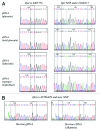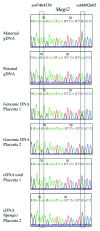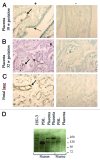A genome-wide approach reveals novel imprinted genes expressed in the human placenta
- PMID: 22894909
- PMCID: PMC3466192
- DOI: 10.4161/epi.21495
A genome-wide approach reveals novel imprinted genes expressed in the human placenta
Abstract
Genomic imprinting characterizes genes with a monoallelic expression, which is dependent on the parental origin of each allele. Approximately 150 imprinted genes are known to date, in humans and mice but, though computational searches have tried to extract intrinsic characteristics of these genes to identify new ones, the existing list is probably far from being comprehensive. We used a high-throughput strategy by diverting the classical use of genotyping microarrays to compare the genotypes of mRNA/cDNA vs. genomic DNA to identify new genes presenting monoallelic expression, starting from human placental material. After filtering of data, we obtained a list of 1,082 putative candidate monoallelic SNPs located in more than one hundred candidate genes. Among these, we found known imprinted genes, such as IPW, GRB10, INPP5F and ZNF597, which contribute to validate the approach. We also explored some likely candidates of our list and identified seven new imprinted genes, including ZFAT, ZFAT-AS1, GLIS3, NTM, MAGI2, ZC3H12Cand LIN28B, four of which encode zinc finger transcription factors. They are, however, not imprinted in the mouse placenta, except for Magi2. We analyzed in more details the ZFAT gene, which is paternally expressed in the placenta (as ZFAT-AS1, a non-coding antisense RNA) but biallelic in other tissues. The ZFAT protein is expressed in endothelial cells, as well as in syncytiotrophoblasts. The expression of this gene is, moreover, downregulated in placentas from complicated pregnancies. With this work we increase by about 10% the number of known imprinted genes in humans.
Figures






References
Publication types
MeSH terms
Substances
LinkOut - more resources
Full Text Sources
Miscellaneous
